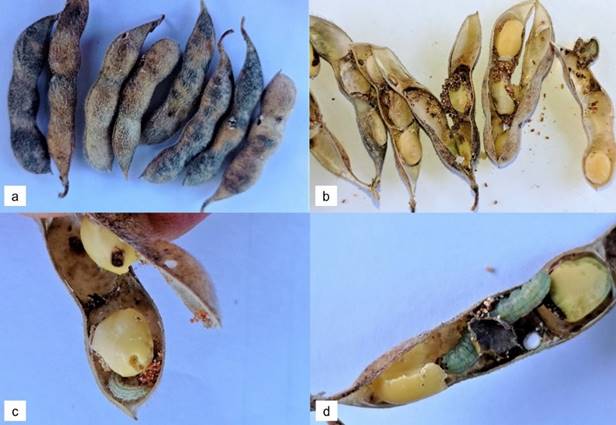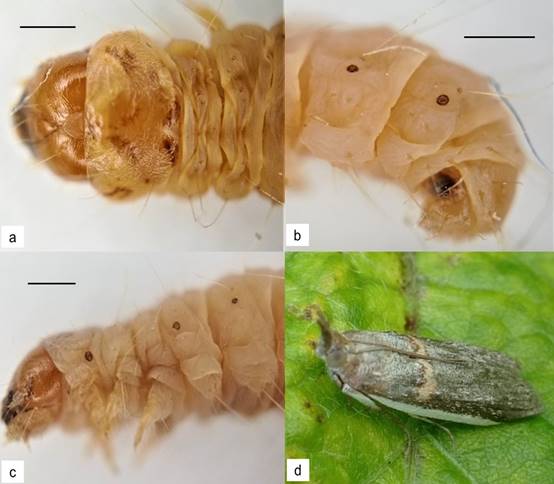INTRODUCTION
The pod borer Etiella zinckenella (Treitschke) (Lepidoptera: Pyralidae) is considered a cosmopolitan pest. This species feeds mainly on fabaceae seeds, including peas (Pisum sativum), common bean (Phaseolus vulgaris) and soybean (Glycine max)1.
The population of E. zinckenella increases in dry and warm seasons, which also allows a higher incidence in crops2. Furthermore, this pest can survive during the winter on host crops such as Crotalaria sp.3.
In addition, E. zinckenella is considered a difficult-to-control pest when soybeans are in the pod stage, where insecticide applications are made without considering their effectiveness or economic thresholds 4. When the attacks of E. zinckenella to the soybean crop are severe, the losses can reach to 80%, when control tactics of this pest are not carried out 5) .
In Paraguay, this pest was recorded in Villarrica in 19566 and later a mention was made of its presence in Paraguay7, so the aim of this work was to document the record of this insect attacking soybean crops in Itapúa department, Paraguay.
During the 2021/2022 soybean production season, the presence of E. zinckenella caterpillars was observed in Itapúa (Paraguay) fields (Table 1). This season was characterized by the occurrence of a generalized drought in the country, which affected soybean production8. Caterpillars were collected from individual pods of soybean plants previously identified with pest entry holes (Figure 1). Subsequently, they were preserved in 70% ethanol in the Multiple Uses Laboratory of the Technological Development and Innovation Center (CEDIT) in Natalio, Itapúa (Paraguay), where morphological characterization was carried out using taxonomic keys of immature stages of the Pyralidae family9 and keys to immature stages of lepidoptera10.
Table 1. Location and date of observation of Etiella zinckenella in soybean fields in Itapúa, Paraguay.
| Location | Geographical coordinates | Observation date | ||
| S | W | |||
| Bella Vista | 27°02'07.3" | 55°31'38.5" | 10/12/2021 | |
| Capitán Meza | 26°52'11.2" | 55°18'53.9" | 10/12/2021 | |
| Edelira | 26°43'50.4" | 55°17'14.1" | 15/12/2021 | |
| Natalio | 26°40'33.7" | 55°07'53.9" | 20/01/2022 | |
| Pirapó | 26°46'38.3" | 55°29'35.5" | 10/12/2021 | |
| San Rafael del Paraná | 26°32'04.4" | 54°56'40.4" | 11/02/2022 | |
| Tomás Romero Pereira | 26°34'49.5" | 55°14'09.0" | 11/02/2022 | |

Figure 1 Damage caused by Etiella zinckenella. (a) perforated pods; (b, c) soybeans with damage and caterpillar feces; (d) Etiella zinckenella caterpillar feeding.
The DNA extraction and molecular identification were carried out in the Molecular Biology Laboratory of the Faculty of Science and Technology at the National University of Itapúa, Encarnacion, Itapúa, Paraguay. The larvae morphology detected in soybean pods and seeds concord with that described by other researchers9-12 for E. zinckenella larvae, presenting the eighth-grade blowhole, abdominal segment at the same level as the previous ones, three ventral setae can be seen from the third to the sixth abdominal segment, a bright ring around the SD1 bristle on the eighth abdominal segment, with three setae on the lateral group of the ninth abdominal segment and thoracic plate with a characteristic pattern for the species (Figure 2).

Figure 2 Morphological characteristics of Etiella zinckenella observed in Paraguayan soybean fields. (a) Chest plate; (b) Lateral detail of the last abdominal segments; (c) Lateral view of the head and thorax; (c) Adult captured in soybean culture. Bars = 1mm.
Genomic DNA was extracted from the thorax and head of one adult, with The Wizard® Genomic DNA Purification Kit (Promega). To verify the identity, the barcoding region of the mitochondrial gene cytochromeoxidase 1 (CO1) was amplified with the following primers: LepF1: ATTCAACCAATCATAAAGATATTGG and LepR1: TAAACTTCTGGATGTCCAAAAAATCA13. The resultant amplicons were sequenced at Macrogen (Seoul, Republic of Korea), and the consensus sequence was compared use with the GenBank database with the Blastn tool. Obtaining a consensus sequence of 599 bp, which presented a high percentage of identity (96%) with accesses of the species E. zinckenella.
This is the first record of E. zinckenella affecting pods in soybeans fields in Itapua, Paraguay. Future investigations could focus on evaluating the loss caused by this pest to determine economic and damage thresholds, as well as determining resistance in the varieties used in Paraguay and evaluating the effectiveness of biological and chemical insecticides with the aim of making proposals for their management integrated from this plague.












 uBio
uBio 


